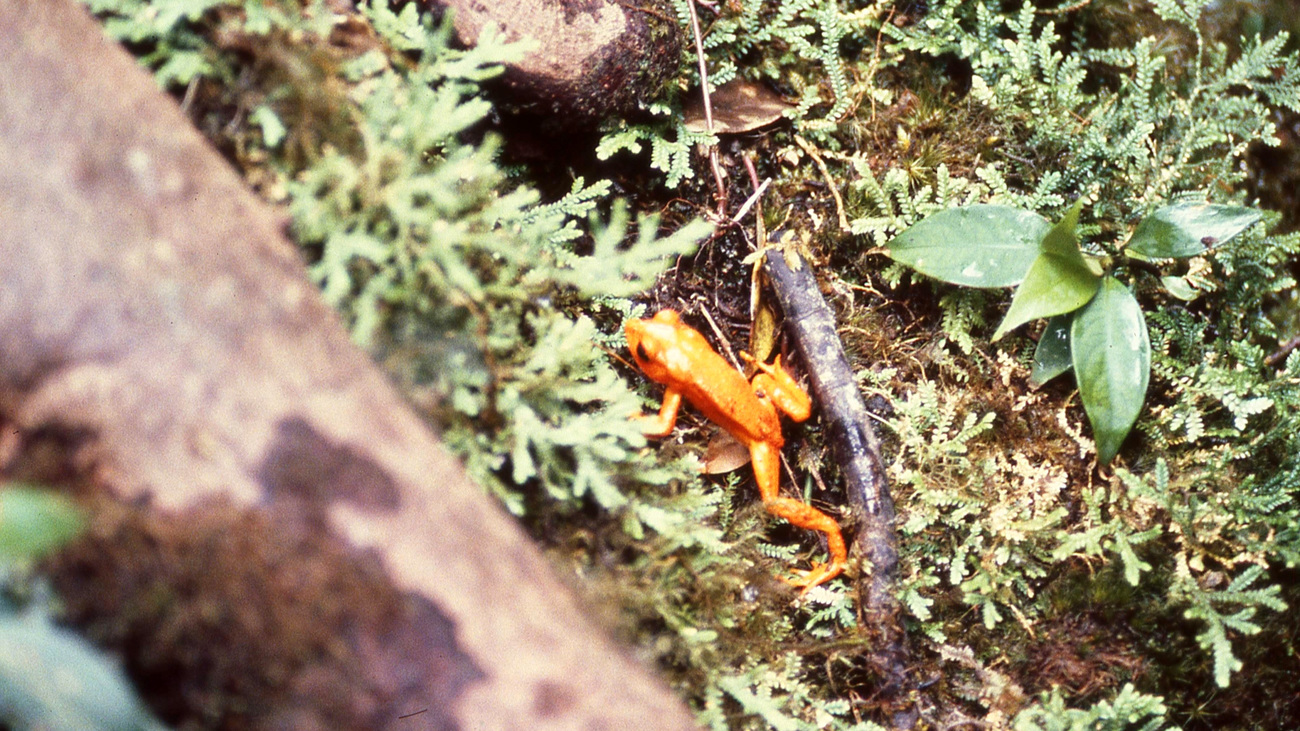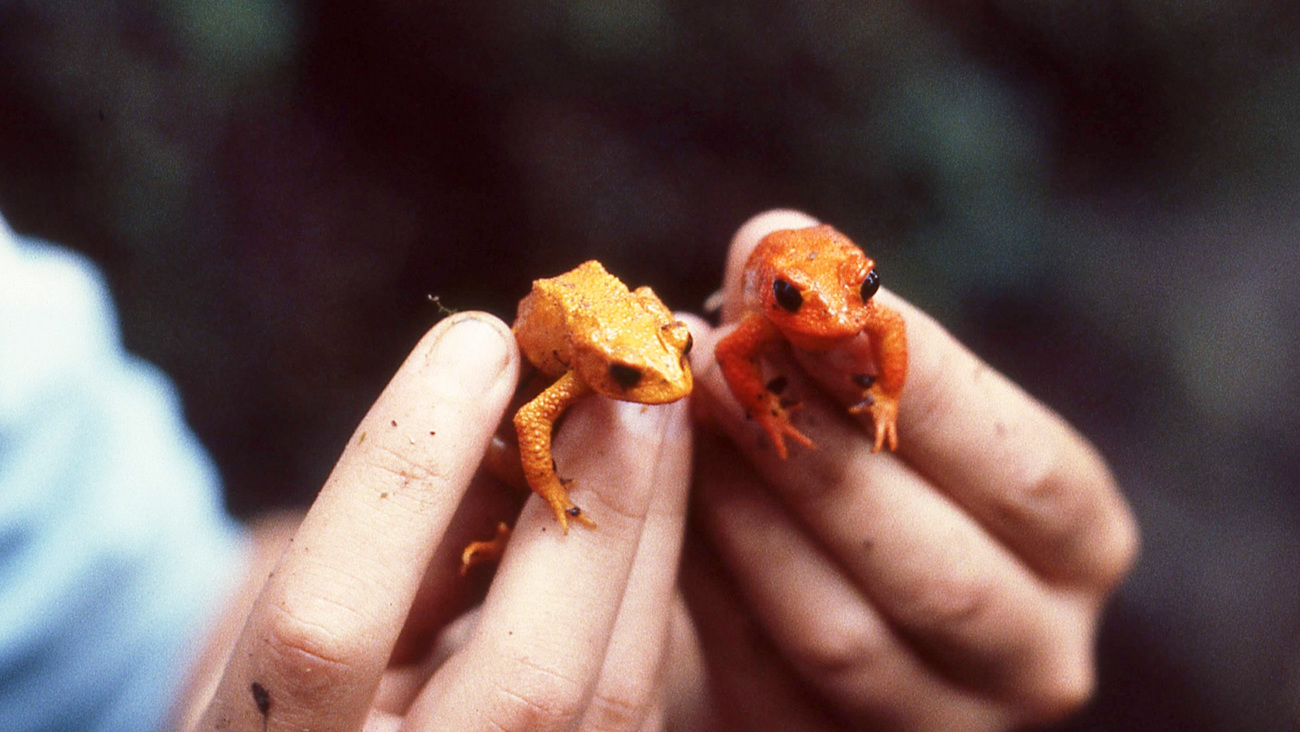Golden toads
What is a golden toad?
The golden toad (Incilius periglenes) is sadly presumed to be extinct. Its last recorded sighting was in 1989, and the species was officially listed as extinct in 2004. Their common name can be attributed to the strikingly vibrant golden-orange skin of male golden toads, which is unusual among amphibians. Female golden toads had dark to pale olive skin—more typical of toads—with little red spots that had yellow outlines. It was a small toad species, only reaching lengths of up to 5.5 centimeters, though females were typically larger than males.
Golden toads were once native to the high-altitude cloud forests of Costa Rica, around 1,500 meters above sea level—an ecosystem characterized by high humidity, constant mist, and a canopy of foliage. As golden toads could only be found in four square kilometers of this range, the species was highly sensitive and vulnerable to environmental changes. One of the theories for the extinction of the golden toad is a sudden change in climate, where even just a couple of years of abnormal weather patterns, such as severe droughts, could have wiped out their population. The other theory is that golden toads may have gone extinct after exposure to the chytrid fungus, which thrives in warm, dry conditions, that has threatened several toad species around the world.
Though they spent most of the year in moist underground burrows, golden toads would emerge during the spring mating season, which coincides with the rainy season. Male golden toads would wait in small ponds and puddles for the females to join them for mating. There was strong competition between the male golden toads, as they would vastly outnumber the females by roughly eight males to one female. Sometimes, non-paired males could be spotted attacking mating golden frogs in an attempt to mate with a female. After mating, each female would lay roughly 200 eggs in the water, which would then hatch approximately two months later. Juvenile male and female golden frogs were of a similar size and color, making them difficult to distinguish until they became adults.
In 1987, over a thousand golden toad adults were observed mating. Over the following two years, though, just a single male individual was spotted, with the last ever sighting occurring on 15 May 1989.
Like most amphibians, the golden toad’s diet consisted mainly of insects. They would sit still and wait for an insect to pass by, using their camouflaged appearance to remain undetected. Once the prey was close enough, they would project their sticky tongues out to catch and eat it.
As both a predator and prey, golden toads were an integral part of the food web of the ecosystem they inhabited. With the species now extinct, it will naturally affect the rest of the food web, depriving their predators of a specific food source and risking an overpopulation of local insect prey. Golden toads also served as bioindicators, with their health reflecting the health of their environment. Their disappearance can be linked to global warming and the resulting increased incidents of severe drought, as well as reduced mist and moisture in the ecosystem. The loss of this species is a stark reminder of the broader impacts of climate change on biodiversity.
Symbolic of both the beauty and fragility of nature, it’s important for us to learn more about the golden toad species and what led to its extinction. This way, we can further educate ourselves on the importance of conservation and the urgent need to mitigate climate change. Keep reading for more facts on this extinct amphibian species.
What is a golden toad’s scientific name?
The scientific name for a golden toad is Incilius periglenes. The genus Incilius is a group of toads within the family Bufonidae, commonly known as true toads.
Are golden toads extinct?
Yes, according to the IUCN Red List, the golden toad species is unfortunately extinct.
The last recorded sighting of a golden toad was in 1989, though it wasn’t officially classed as extinct until 2004. It was previously classed as critically endangered from 1996 to 2003, and endangered from 1986 to 1994.
Where did the golden toad live?
Before the species went extinct, the golden toad was native to the Monteverde Cloud Forest Reserve in Costa Rica, spanning a range of approximately four square kilometers. They lived underground in burrows for the majority of the year and emerged to mate during the rainy season in spring.
Threats
Golden toads became classified as extinct in 2004 because they have not been seen since 1989. Researchers carried out thorough searches in the very specific regions they were previously known to inhabit in high numbers just two years prior, but unfortunately, they failed to locate any golden toads. There are two primary theories as to why the golden toad went extinct: climate change and chytrid fungus.
Climate change
Golden toads’ breeding patterns and health relied heavily on having the right environmental conditions. They were a very isolated species, spanning only four square kilometers (2.5 square miles) of a cloud forest in Costa Rica, which meant that if the ecosystem’s weather patterns changed, the species would be extremely vulnerable to extinction. Climate change has led to unpredictable fluctuations in weather patterns, which led to two consecutive years of drought in the golden toad’s habitat. During these years, the population of golden toads was believed to have fallen drastically from over a thousand, to just a few, until they went extinct.
Chytrid fungus
Chytrid fungus was another large threat to golden toads, and it continues to threaten amphibian species around the world. This highly toxic fungus thrives in dry, hot environments and is thought to have spread through the golden toad’s natural habitat as a result of the changing weather conditions triggered by climate change.
A highly toxic fungus, it attacks the skin of frogs and toads, causing it to thicken. As a result, their skin can’t absorb salts and water, which prevents oxygen from entering their bodies. Eventually, they suffocate. The small, isolated population of golden toads would have been at a very high risk of extinction if a fatal fungal infection spread through it.
FAQs
When was the golden toad discovered?
Golden toads were first discovered in 1964 within the high-altitude Monteverde Cloud Forest Reserve in Costa Rica. For the following 25 years, the species could be seen during their mating season, which occurred during the rainy season.
What did golden toads look like?
The species had extreme sexual dimorphism, meaning females looked very distinct from males. Male golden toads were a bright, golden-orange color, while female golden toads were olive green, featuring red spots with yellow outlines.

How big was the golden toad?
Golden toads were small amphibians. The females were typically longer than the males, though they would usually only reach 5.5 centimeters long. Female golden toads had large cranial crests above their eyes, while male golden toads had longer limbs and noses.
What did the golden toad eat?
The diet of golden toads consisted primarily of insects typically found in their cloud forest habitat, including ants, beetles, and flies.
How did the golden toad reproduce?
Golden toads reproduced during the rainy season in spring. Male golden toads gathered in large numbers in ponds and puddles and waited for the females. Two years before they went extinct, golden toads were observed to mate in groups of over a thousand. The males grabbed onto any golden toad that passed, only then identifying the other toad’s sex. If he found that it was a female, he would engage in amplexus—the mating position of frogs and toads—until she spawned around 200 eggs, which she then laid in the water. The eggs hatched roughly two months later.
Male golden toads engaged in aggressive competition with each other, as they significantly outnumbered the females in a ratio of approximately eight to one, making the competition to find a mate fierce.
Were golden toads poisonous?
No, golden toads were not poisonous. There is an amphibian called the golden poison frog which is poisonous, but it is a different species.
How many golden toads are left?
The golden toad is considered extinct, with no mature individuals known to exist in the world. Up until the year 1987, more than 1,500 adult golden toads were observed during their mating season, when they emerged from their underground burrows to mate in rainwater puddles and ponds. Just one year later, in 1988, only 10 or 11 golden toads were spotted. The last golden toad sighting was of a single adult, on 15 May 1989.
When did the golden toad go extinct?
Golden toads were officially classified as extinct in 2004. However, the last recorded sighting of a golden toad was on 15 May 1989.
The most significant factor believed to have contributed to the extinction of the golden toad is climate change. The species inhabited the Monteverde Cloud Forest in Costa Rica, which is characterized by high humidity, constant mist, and a rainy season in spring. These weather conditions are closely linked to the mating behaviors of golden toads, who bred in pools of rainwater. Changes in climate, such as a decrease in mist levels and rain, therefore heavily affected golden toad populations by impacting their breeding ability. Because golden toads only occupied a range of four square kilometers, changes in the local climate didn’t just impact a small population of the species—they impacted the entire species.
Globally, amphibians have been affected by the spread of the chytrid fungus, which causes a disease called chytridiomycosis. It’s thought that changes in the climate may have led to the growth of chytrid fungus in the golden toad’s habitat, contributing to the extinction of the species.
Was the golden toad the only amphibian to disappear?
No, sadly a type of harlequin frog which was also native to Monteverde has not been recorded since the late 1980s. Various other amphibian species are believed to have gone extinct in Central America, with little to no sightings of these frogs and toads in recent years.
How can you help?
IFAW works tirelessly for the conservation of species that are vulnerable to extinction. We are committed to supporting nature-based climate change solutions to mitigate the climate crisis, which threatens up to one million species worldwide.
